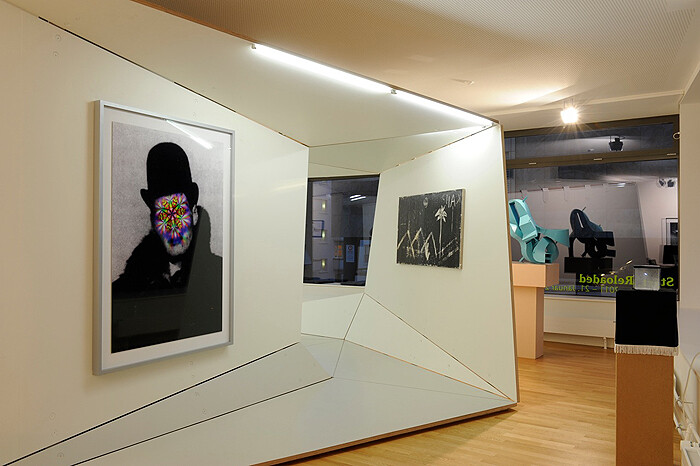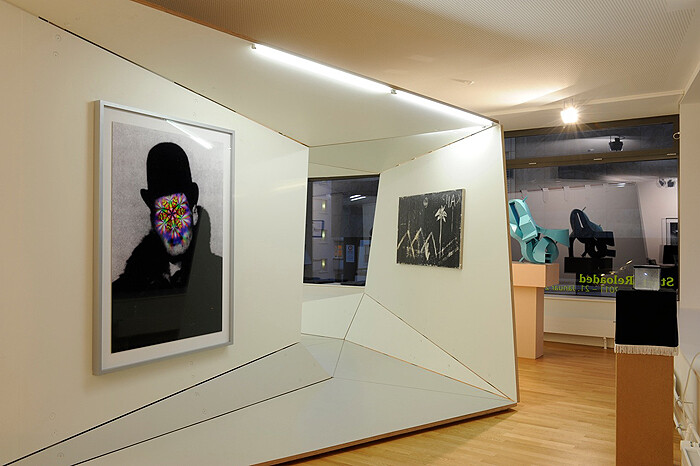Up until now, Grieder Contemporary was located in the lush suburb of Küsnacht, just outside of Zurich. Delightful though this was—with opening parties spilling over into the garden of the gallerist’s modernist villa—getting there could be a pain and short opening hours further deterred many visitors. Now relocated to central Zurich, the new gallery space also resists the bland packaging of the white cube. It’s as if the gallery has been quasi-invaded by an alien capsule designed by Baierbischofberger Architects that landed in the horseshoe-shaped commercial space. It’s a crinkled pod, it’s white, and it’s many facets (of laminated CNC cut layered wood veneers) are hinged together to create an experience akin to walking into a Frank Nitsche painting (who coincidentally showed with Grieder previously), or kind of like walking into an opened-up envelope (or several) that’s ready for the recycling bin.
Works by eleven artists that the gallery work with, or plan to in the near future, (Melli Ink, Alicja Kwade, Dieter Meier, Johannes Albers, Kerim Seiler, Gregor Hildebrandt, Christian Jankowski, Jorinde Voigt, Nic Hess, Monica Bonvicini and Thomas Kiesewetter) are displayed in and around this unfolded chamber. It is far from being a straightforward space; the walls are not vertical nor are the floor surfaces horizontal, but some crisp smaller works seem to look right at home, nonetheless. “Start.Reloaded” is evidently a statement of intent for the future, a meeting of Berlin and Zurich, but also an inadvertent portrait of the artists’ approaches to commerce to boot. These range from studied indifference (Kwade) to avid engagement (Jankowski), with much in between.
To start between those poles, take Kerim Seiler’s subject Cravan, (2011), the pugilist, poet, and publisher Arthur Cravan, a character whose life and even death were a master class in self-promotion and construction of identity. Seiler reproduces one of few images of Cravan with a kaleidoscopic blur in front of his eyes; here the chameleon Cravan has been made into even more of a shape-shifter. Along a similar vein, Dieter Meier is known for his successful forays into music, poker, and beef and wine production. But Grieder shows some of his early artworks such as Jumps (1974), Lost Sculptures (1975), and Lost Pieces (1976), with which he lays claim to short-lived creative gestures like those of Erwin Wurm or Fischli and Weiss.
There are two different works from Christian Jankowski in the show, and though the extraordinarily straight-faced commercial commissioned for this year’s frieze projects, The Finest Art on Water (2011), has magnetic appeal, Jankowski’s strategy of adding noughts to the price of two yachts to designate them as art is about as complex as operating a paddleboat. Compared with the snake-oil sales pitch of the star of Jankowski’s commercial, Nic Hess’s drawings seem tame at first, using his familiar tactic of combining and corrupting commercial logos and symbols. But Hess’s Untitled (ocelot) (2011) lurks beside Jankowski’s video, showing its fangs and lips curled in animosity.
Beside these showmen, the female artists present are, on the whole, solemn and stoically ascetic. Jorinde Voigt’s parsing of the view of a poplar is, as is her wont, covered in tight script and numerous interconnections. It remains to be seen, though, if there is more to these elaborate doodles that might appeal to viewers who like their chaos neatly ordered. Alicja Kwade shows two very beautiful photographs: one depicting the glow of a swinging lamp; and the other of burning, falling matches captured the instant before they hit the ground. These may, like Meier’s, record fleeting events, but in her works all human traces are erased.
The conclusion that could be drawn from these works is that while the women artists remain focused and subdued, their male colleagues seem to apply flamboyance with impunity. Of course, the exhibition gives us only a glimpse into the gallery program, but the pedestrian reality of today is that artists are forced into being marketers of themselves. Originality is fiercely difficult to contest and being an artist (who sells) involves blurring boundaries. In other words, creative individuality is fragile, for it exists hand in hand with being a creative individual.







